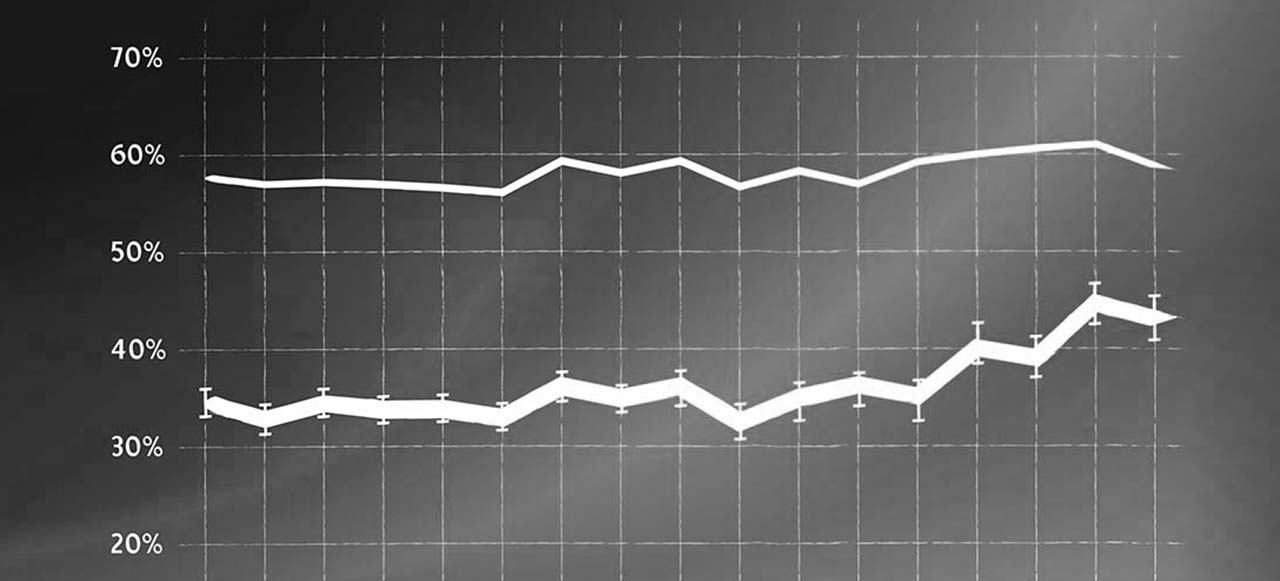
How diverse is philosophy? In this paper we explore recent data on the racial, ethnic, and gender diversity of philosophy students and faculty in the United States. We have found that women are underrepresented in philosophy at all levels from first-year intention to major through senior faculty. The past four years have seen an increase in the percentage of women philosophy majors at the undergraduate level, but it remains to be seen if this recent increase in the percentage of women will eventually also show at more advanced stages. Temporal trends since 2000 also show substantial increases in the racial and ethnic diversity of philosophy majors at all levels of education from first-year undergraduate through PhD, with substantial declines in the percentage of non-Hispanic White philosophy majors and substantial increases in all other commonly measured racial/ethnic groups except for Native American / Alaska Native. Despite generally increasing diversity, people who identify as Hispanic (any race), or non-Hispanic Native American, Alaska Native, or Black remain substantially underrepresented in philosophy at all levels compared to their presence in the U.S. population, and in some cases also as compared to other majors. Now let’s take a look at the data.
Since at least the 1990s, philosophy has been among the least demographically diverse academic disciplines in the United States, with substantial and well-documented imbalances at least in race and gender, as well as likely imbalances relative to other academic specialisations or the population as a whole in ethnicity or national background, socio-economic status, and possibly disability status.[1] In this article, we examine the most recent data from multiple sources on race, Hispanic/Latinx ethnicity, and gender in philosophy in the U.S., from first-year university students’ intention to major through entry into the professoriate. Where possible, we will also examine temporal trends since the year 2000. We focus on race, Hispanic/Latinx ethnicity, and gender due to the availability of data from multiple databases over time for these demographic characteristics, allowing both temporal analysis and analysis from the beginning to the end of the academic “pipeline” into philosophy.
1. First-Year Intention to Major: The HERI Database.
Every year, the Higher Education Research Institute (HERI) conducts a “Freshman Survey” of entering college and university students in a large number of institutions across the United States. The most recent available year with discipline specific data, 2016, included 171,300 respondents from 253 colleges and universities. (HERI provides only summary data from more recent years, not breaking responses down by discipline.) Weaknesses in the database include (1.) variable institutional participation by institution type (for example higher among relatively wealthy private institutions), (2.) failure to report student response rates, which might be lower for some groups of students or institutions, and (3.) an approximately 50% decline in institutional participation and total responses since the year 2000.[2] Despite these shortcomings, the HERI data provide unique information, not available from other sources, about nationwide demographic trends among first-year students.
From Fall 2000 through Fall 2016, HERI collected first-year intention to major from 4.9 million students (asking students to “please indicate your intended major”, with “Philosophy” as one of several dozen options). Race/ethnicity questions have varied over time, but students were always able to respond with more than one race. HERI currently aggregates all past and present race/ethnicity questions into seven categories: American Indian (including Alaska Native), Asian (including Native Hawaiian and other Pacific Islanders), Black, Hispanic, White, Other, and Two or More Races/Ethnicities (including Hispanic plus any other race/ethnicity category). In this database, a respondent would be marked as “Hispanic” only if they did not also indicate another race/ethnicity. If they indicated, for example, both “Hispanic” and “Black”, they would be classified as “Two or More”. Overall, 0.35% of students expressed an intention to major in philosophy.
Only a tiny percentage of first-year students identified as American Indian: 0.2-0.3% overall, and 0.0-0.4% of those intending to major in philosophy, with no obvious temporal trends. This is substantially lower than the 0.9% of U.S. population age 15-19 that are estimated to identify as non-Hispanic American Indian or Alaskan Native alone in this time period by the U.S. Census Bureau.[3] Students responding in the “Other” category were also few and steady, both overall (1-2%) and in philosophy (1-4%). The percentage of students identifying as non-Hispanic White steadily declined, both overall (from 74% in 2000 to 52% in 2016) and in philosophy (from 76% to 48%).
Figures 1a-d show the percentage of students in the Asian, Black, Hispanic, and Two or More categories by year, both in philosophy and overall (excluding respondents without a valid answer: 3.6% overall and 2.4% among students intending to major in philosophy). As is evident from the figures, the percentage of students entering college intending to major in philosophy who identify as Asian, Hispanic, or multiracial approximately matches the overall percentages across all majors. Until recently, Asian students may have been a little underrepresented and multiracial students a little overrepresented in philosophy compared to other majors, but both groups are now near proportionality. In the early 2000s, Black students were about 7% of students overall but only about 3% in philosophy. By 2013, however, Black students are approximately proportionately represented in philosophy relative to their participation in the university as a whole. The sharp spike in 2016 might be noise: With only 494 total philosophy respondents that year, the estimate is only accurate +/- 2%. Despite the increase, the percentage of philosophy majors identifying as Black remains lower than the approximately 15% of the U.S. resident population aged 15-19 estimated to identify as non-Hispanic Black alone in this time period by the U.S. Census Bureau.
Figures 1a-d. First-year intention to major in philosophy by race/ethnicity since 2000. Error bars indicate +/- one standard error.
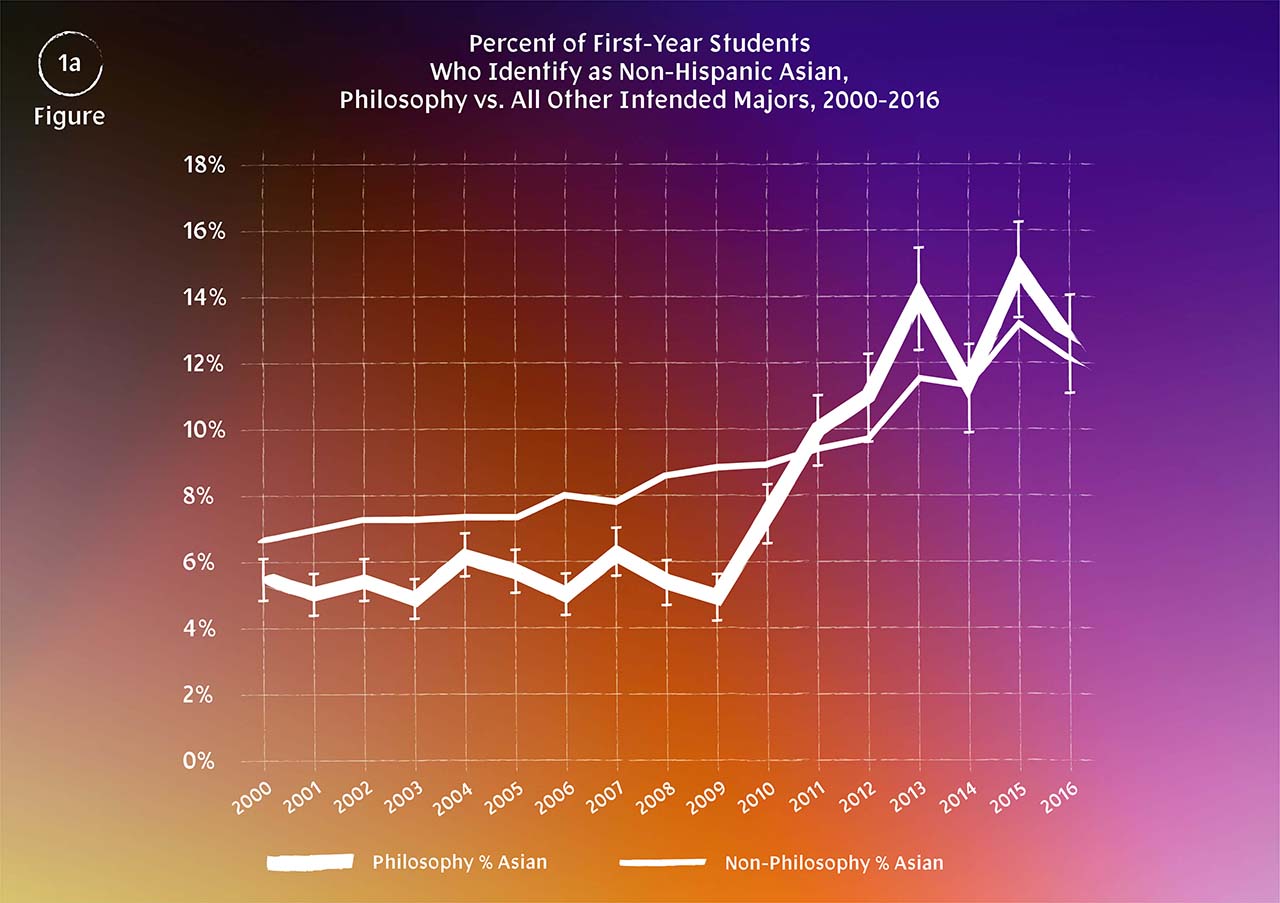
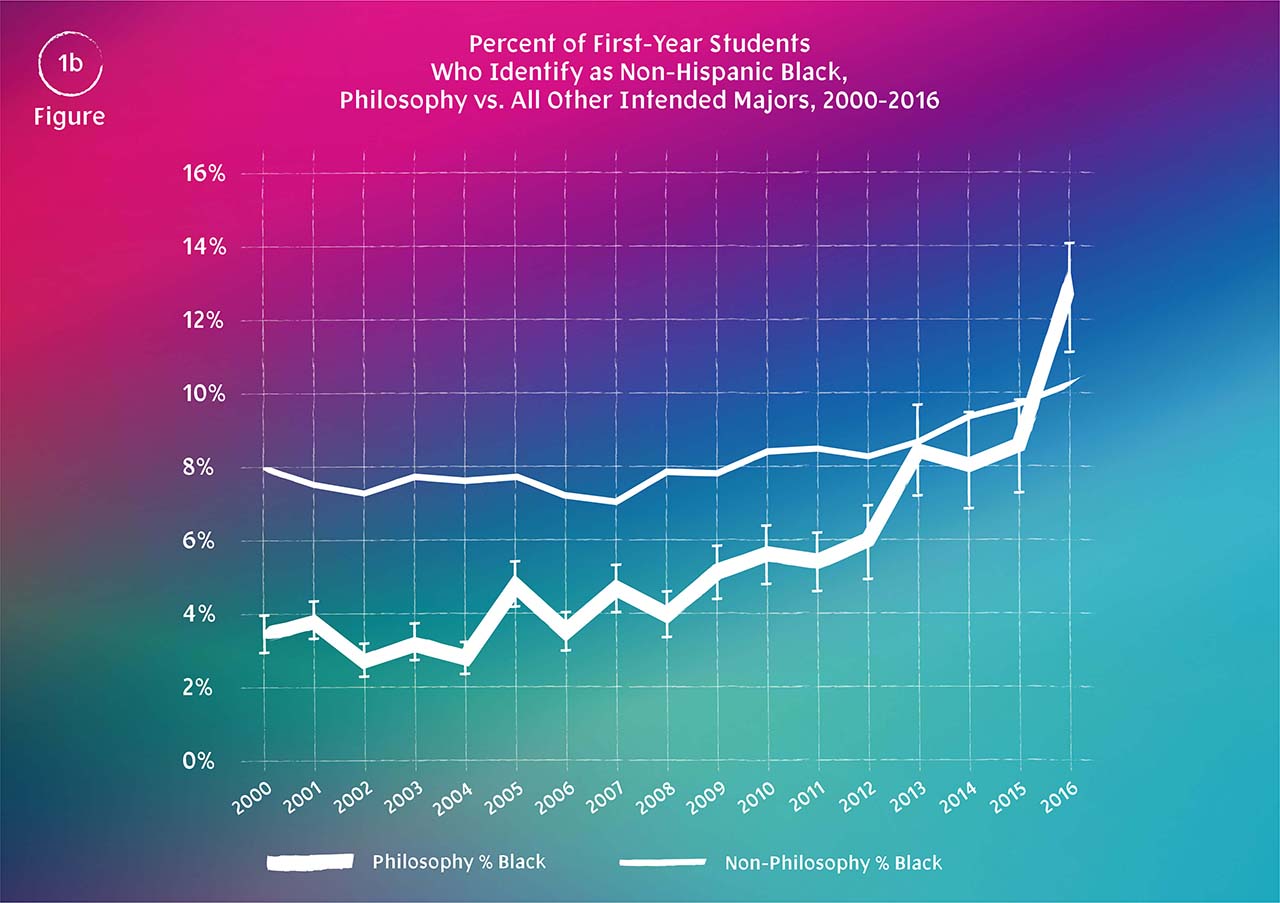
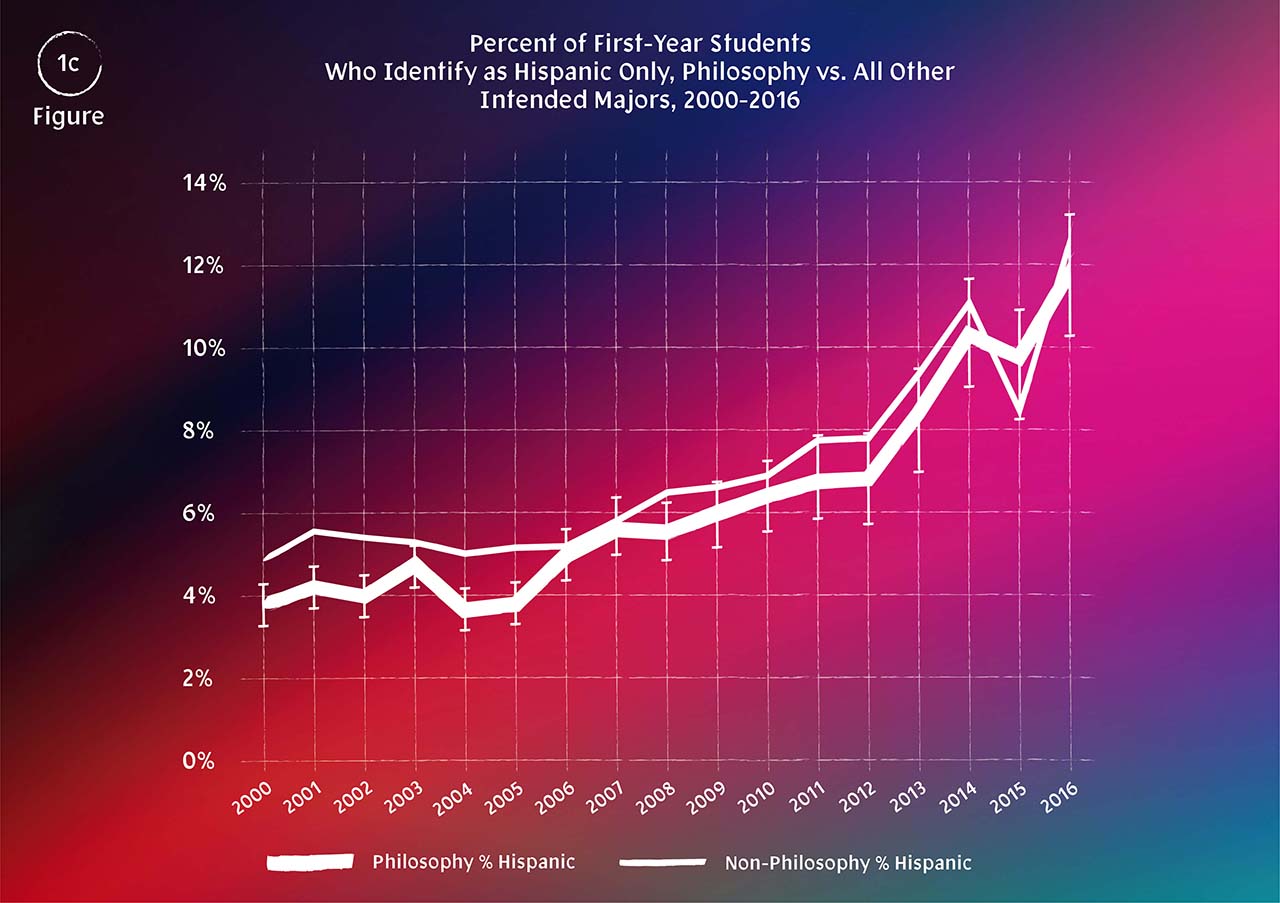
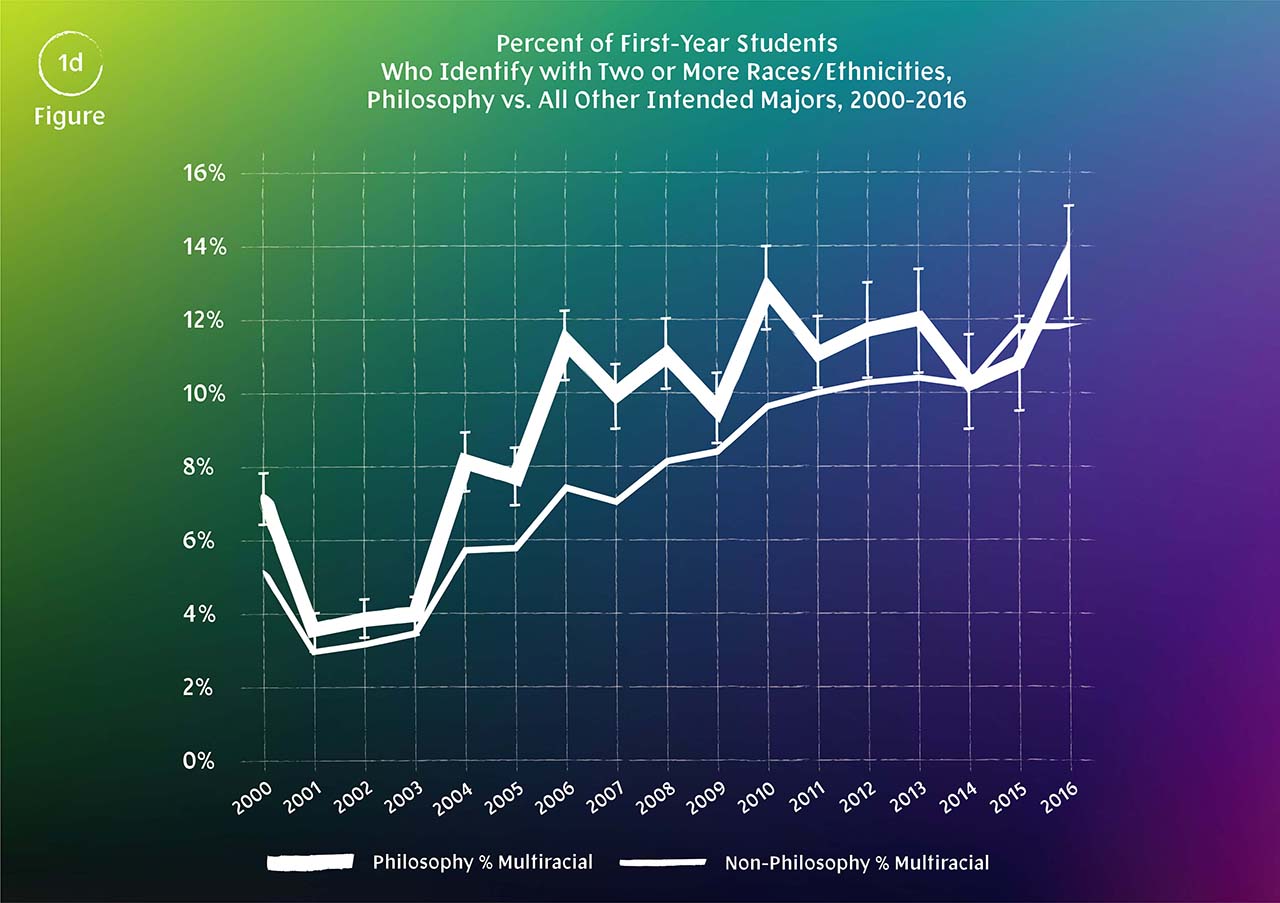
HERI asks about sex or gender with the prompt “your sex” and response options “male” and “female”.[4] Through 2016, there was no option for nonbinary or other. In 2015, HERI added a “Do you identify as transgender?” with response options “yes” and “no”. Overall 0.3% of respondents and 0.7% of students intending to major in philosophy answered “yes”. However, an additional 12.5% of students (9.3% in philosophy) declined to answer, so it is possible the “yes” responses are a conservative estimate. Figure 2 shows temporal trends by gender. As is evident from the chart, while the percentage of women students across all majors has been approximately constant at slightly under 60%, the percentage in philosophy has increased from the mid-30%s to the low 40%.
Figure 2. First-year intention to major in philosophy by gender since 2000. Error bars indicate +/- one standard error.
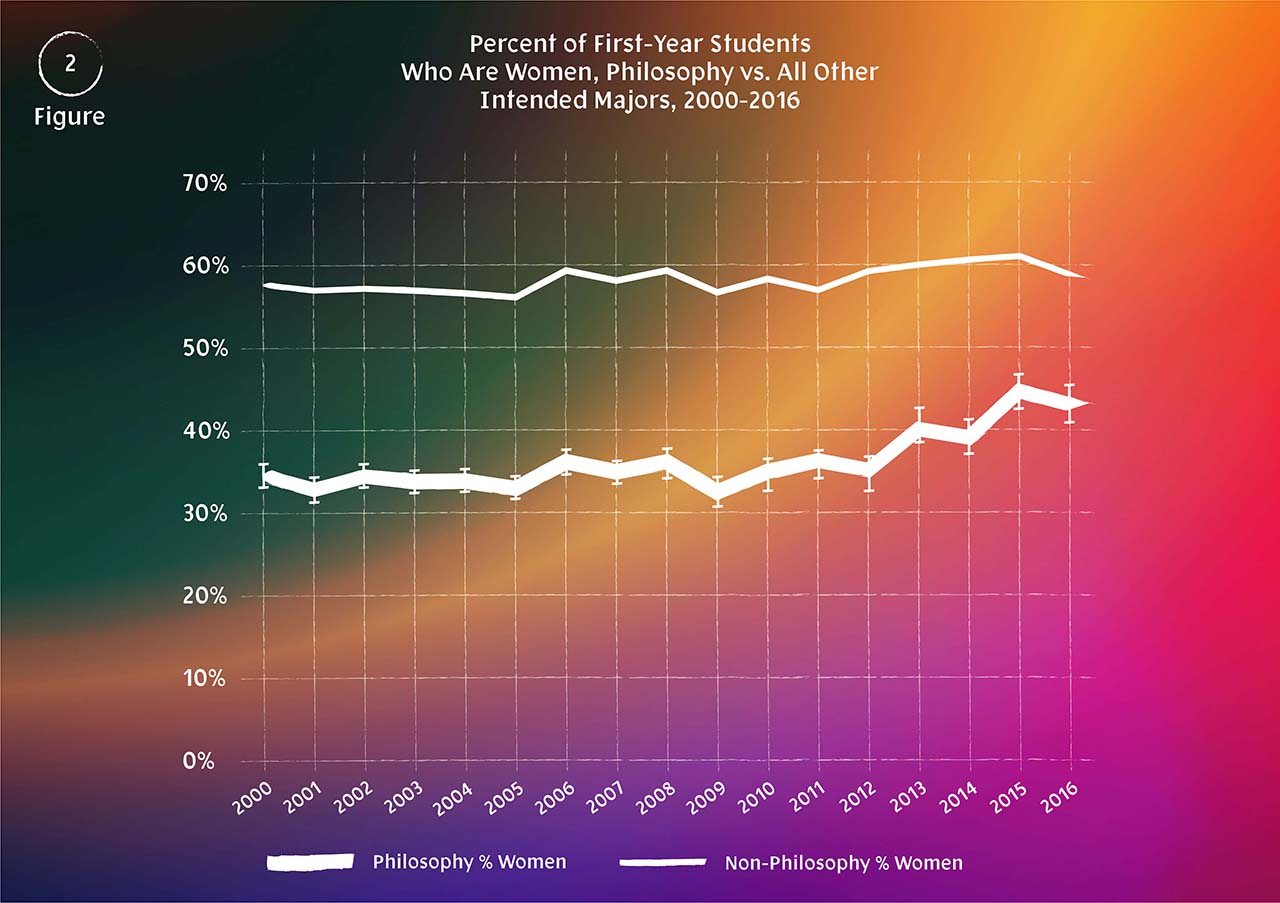
In sum, the HERI data on first-year intention to major show mostly encouraging trends, with increasing diversity over time, most strikingly among Black students. However, the continuing low representation of American Indian students is cause for concern, and first-year students intending to major in philosophy are still disproportionately men compared to the student body overall.
2. Completed Bachelor’s Degrees in Philosophy from the National Center for Education Statistics.
We are not aware of any systematic nationwide data concerning the proportion of students entering with an intention to major in philosophy who then go on to complete that major as opposed to some other major. Rates of transfer both in and out of the philosophy major may be high. Our next dataset, the Integrated Postsecondary Education Data System (IPEDS), from the National Center for Education Statistics (NCES), provides approximately complete data on race and gender for all graduating students at accredited four-year universities in the United States, as supplied by university administrators. These data exclude a small, unknown percentage of students who do not provide the relevant demographic information to their college administrators. Our analysis includes students completing their bachelor’s degree with philosophy as either a first or second major, compared to all graduates.
NCES uses seven racial/ethnic categories: “American Indian / Alaska Native”, “Asian”, “Black or African American”, “Hispanic or Latino”, “Native Hawaiian or Other Pacific Islander” (starting in the 2010-2011 academic year; before that, included with Asian), “White”, and “two or more races” (starting 2007-2008), separating out those categorised as “nonresident alien”. In contrast with the HERI data, all racial categories, including “two or more”, exclude students identifying as Hispanic or Latino. For example, a student who identified as both “Black” and “Hispanic” would be included in the Hispanic category and not in the Black category. Because of this, and also because of the exclusion of students without permanent residency, the NCES and HERI race/ethnicity numbers are not strictly comparable. We analysed data from the 2000-2001 academic year (labelled 2001 in the NCES database), through the most recent available year, 2018-2019.
Over this period, the percentage of nonresident aliens increased, from 3% to 5% of all bachelor’s recipients and from 2% to 6% of philosophy bachelor’s recipients. Throughout the period about 3-5% of students, both overall and in philosophy, were listed as race/ethnicity unknown. These two groups are not included in the analyses below.
Among permanent residents with known race/ethnicity, only a very small percentage of bachelor’s recipients identified as American Indian / Alaska Native and Native Hawaiian or Other Pacific Islander throughout the period: 0.5-0.8% and 0.2-0.3%, respectively, of students overall, and 0.4-1.0% and 0.1-0.3%, respectively, of philosophy students. As in the HERI data, the percentage of students identifying as White declined substantially over the period, from 72% to 57% overall and from 84% to 65% in philosophy. Comparison with the HERI data shows a higher percentage of White students, and a slightly higher percentage of American Indian students, among bachelor’s degree recipients than among students entering with the intention to major in philosophy. However, it is unclear whether these differences are due to differences in reporting techniques or categories, sampling problems in the HERI database, disproportionate entry into or exit from the philosophy major, or higher completion rates by students in these two groups.
Figures 3a-d show the percentage of students in the Asian, Black, Hispanic, and Two or More categories by year, both in philosophy and overall. As is evident from these charts, and broadly fitting with the HERI data, the percentage of Asian, Hispanic, and multiracial students has been increasing steadily both in philosophy and overall. Asian and Hispanic students are approximately proportionately represented in philosophy relative to other disciplines (but not necessarily relative to the overall United States population), while multiracial students might be slightly more common among philosophy bachelor’s recipients than overall. We are hesitant to read too much into either the sharp rise or the possible overrepresentation of multiracial students, due to changes in reporting practices during the period.
The picture for Black students is different. In the HERI database, Black students were underrepresented among students entering college with an intention to major in philosophy in the early 2000s, but by the end of the period (the 2016-2017 academic year), Black students were approximately proportionately represented. In contrast, in the NCES database, Black students are substantially underrepresented throughout the period. It is possible that this is partly due to the temporal offset: Students entering in 2016-2017 intending to major in philosophy would not yet normally have completed their degree by the last available year in the NCES database, 2018-2019. Other possibilities include a tendency for Black students disproportionately to exit (or not enter) philosophy, difference in the questionnaire items or methods, or sampling problems in the HERI database.
Figures 3a-d. Completed bachelor’s degrees in philosophy by race or ethnicity since 2001, U.S. citizens and permanent residents only. Error bars indicate +/- one standard error.
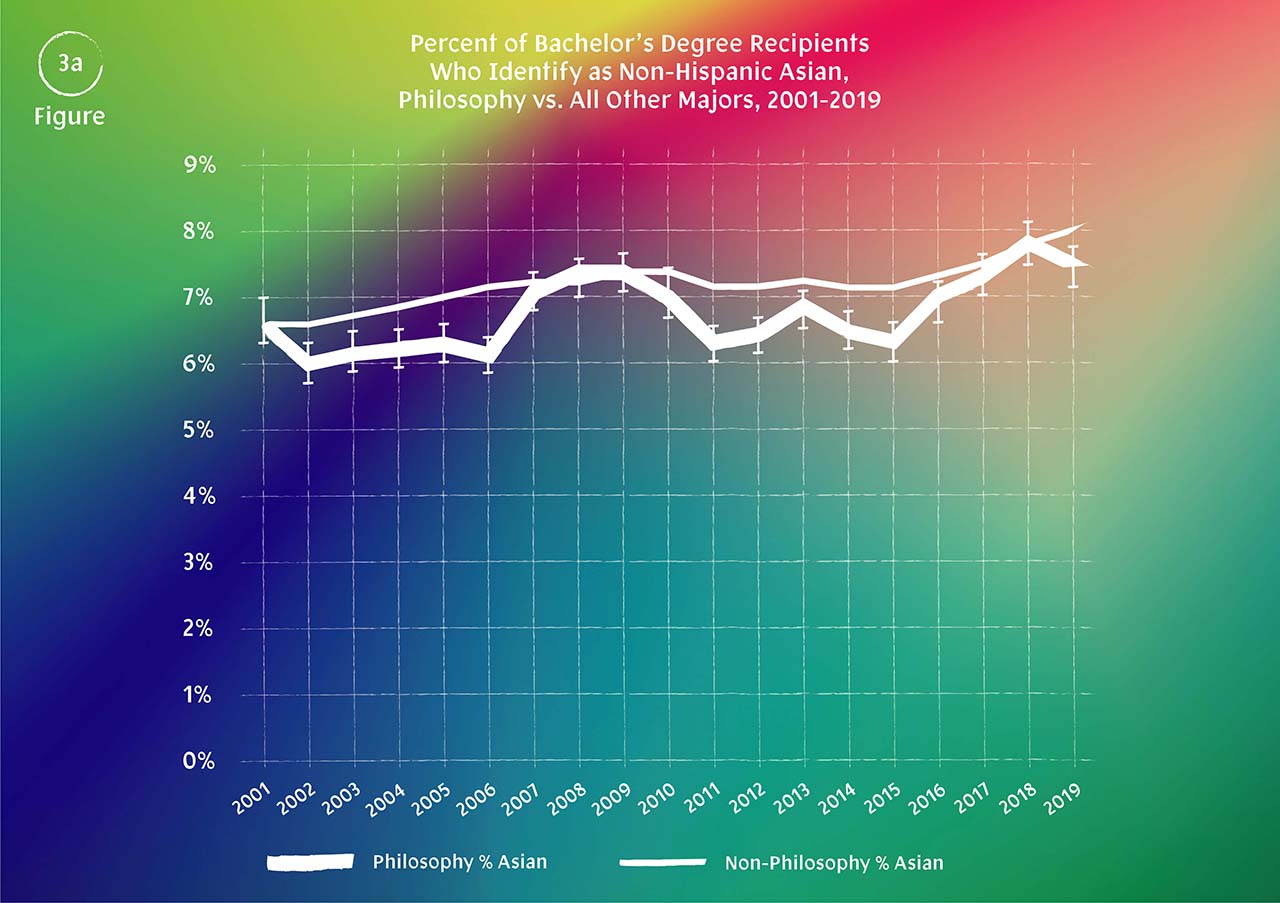
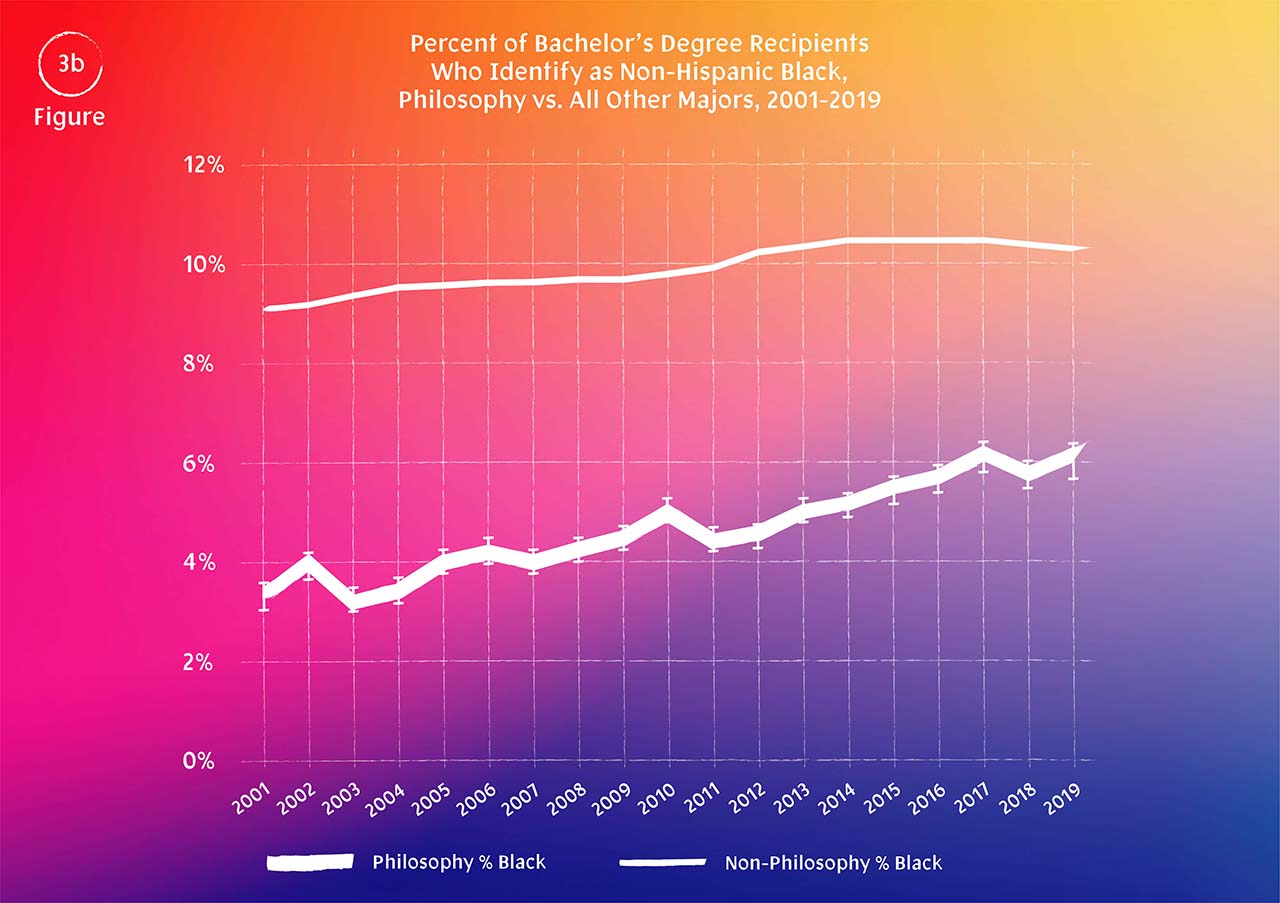
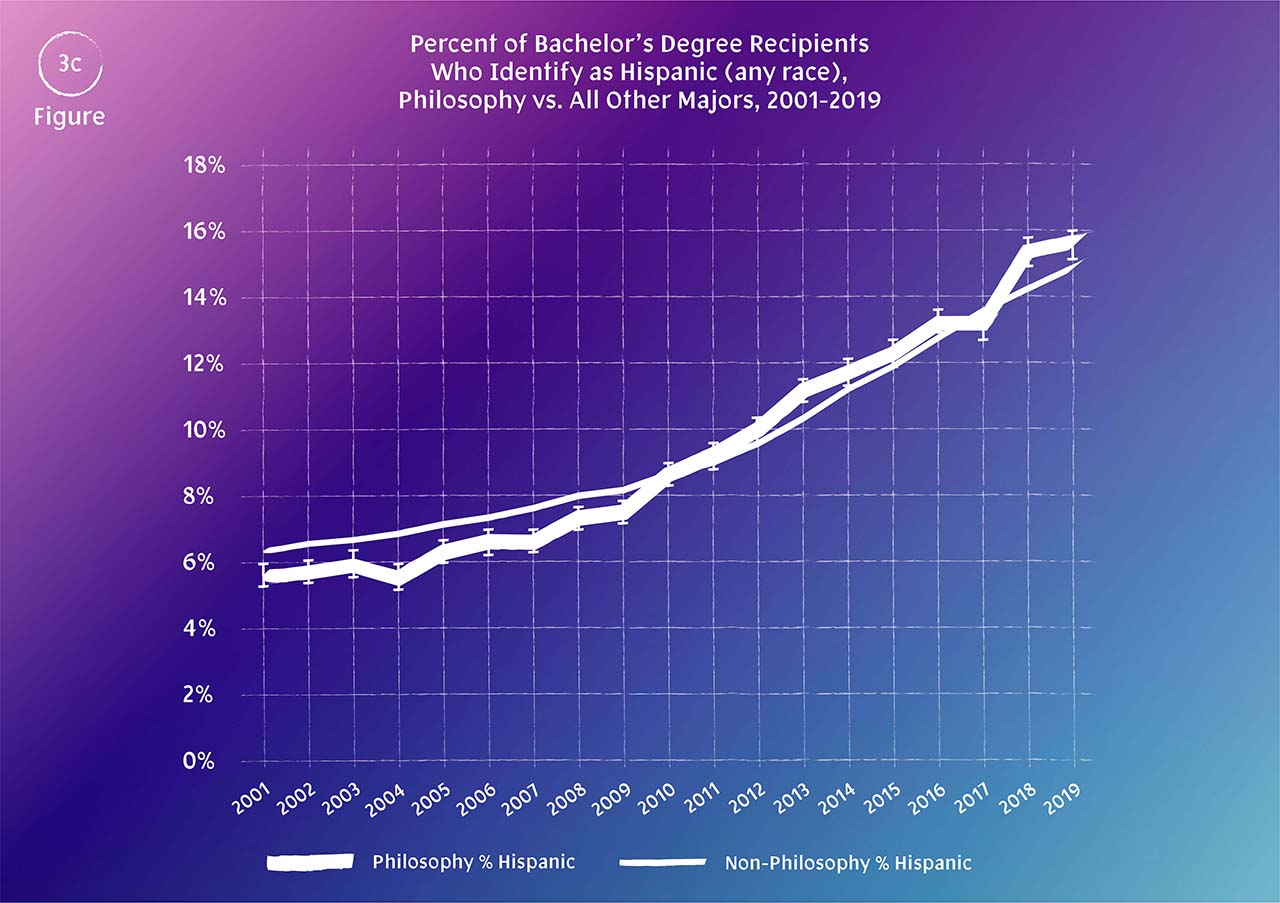
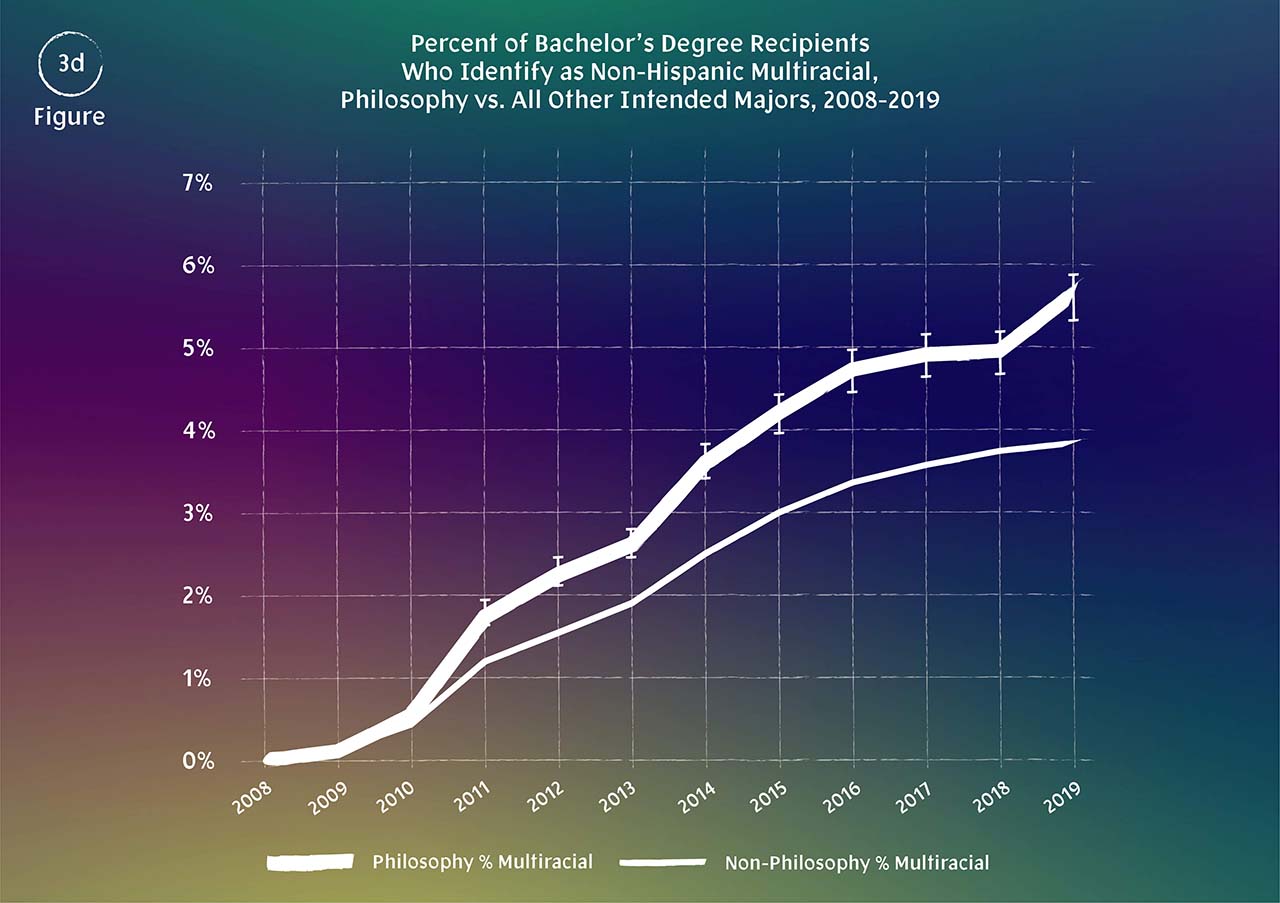
NCES classifies all students as “men” or “women”, with no reported nonbinary categories and no unclassified students. Figure 4 shows temporal trends by gender. As is evident from the chart, while the percentage of women bachelor’s recipients overall has been approximately constant at slightly under 60%, the percentage in philosophy increased; after a long run in the low-30%s numbers increased starting around 2015, crossing over 35% for the first time in 2018.
Figure 4. Completed bachelor’s degrees in philosophy by gender since 2001. Error bars indicate +/- one standard error.
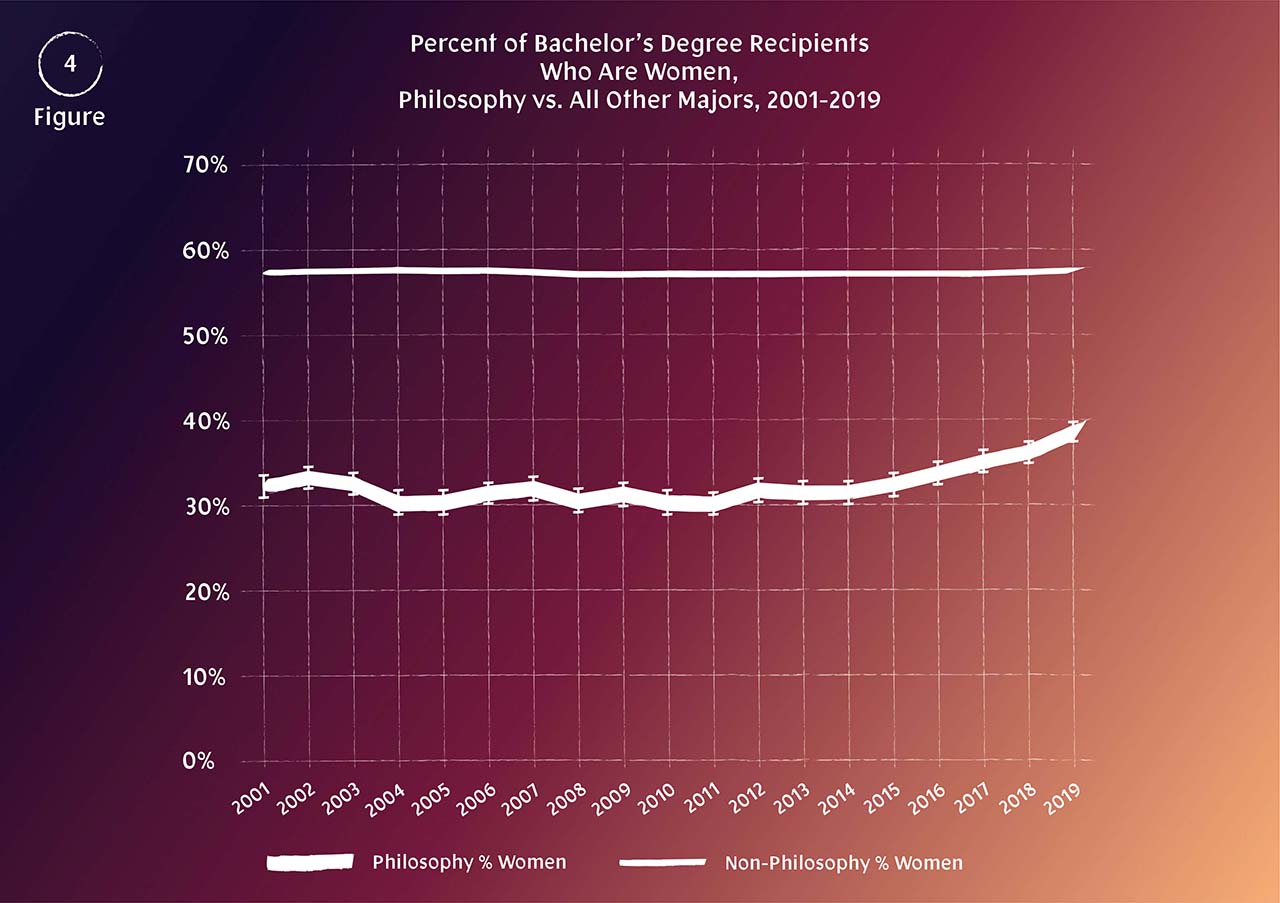
In sum, the NCES IPEDS data on completed bachelor’s degrees, like the HERI data, show increasing diversity over time in both race and gender. However, in contrast with the HERI data, Black students remain strikingly underrepresented, even in the most recent years. Also as in the HERI data, compared to the student body overall, bachelor’s recipients in philosophy remain disproportionately men.
3. Completed PhDs in Philosophy from the National Science Foundation’s Survey of Earned Doctorates.
The National Science Foundation (NSF) conducts a census of all people receiving research doctorates from accredited U.S. institutions, the Survey of Earned Doctorates (SED). The SED contacts doctorate recipients directly by multiple contact modalities, achieving response rates of about 90-95% throughout the period. NSF includes “philosophy” as a subfield and “ethics” as a separate subfield starting in 2012. However, the number of “ethics” PhD recipients is small and merged with the philosophy recipients in the NSF’s data presentation. We examined data from the 2000-2001 academic year through the most recent available year, 2018-2019.
The SED’s race/ethnicity categories exclude temporary visa holders, which was a substantial proportion of PhD recipients across all majors, rising from 24% in 2001 to 33% in 2019, and rising from 12% to 18% among philosophy PhD recipients. Only U.S. citizens and permanent residents are included in the race/ethnicity analyses to follow. Among U.S. citizens and permanent residents, NSF reports the categories “American Indian or Alaska Native”, “Asian”, “Black or African American”, “Hispanic or Latino”, “White”, “more than one race, not Hispanic or Latino” and “other or race not reported”. As in the NCES data, and in contrast with the HERI data, respondents identifying as Hispanic or Latino were classified as belonging to that category regardless of their response to the racial question.[5] “Other or race not reported” constituted 7-15% of students throughout the period (excluding temporary visa holders) and 1-6% of philosophy PhD respondents.
As in the HERI and NCES data, American Indians were underrepresented among PhD recipients overall, 0.3-0.5% throughout the period, compared to 0.8% of the U.S. population aged 25-34. American Indians were even more strikingly absent from philosophy, constituting 0.17% of philosophy PhD recipients across the period. In 10 of the 19 included years, the NSF recorded no American Indian recipients of philosophy PhDs, and 11 were awarded overall.
Figures 5a-d show the percentage of students in the Asian, Black, Hispanic, and Two or More categories by year, both in philosophy and overall. As in the NCES data, Black students remain underrepresented in philosophy, earning approximately 1%-4% of philosophy PhDs throughout the period. Unlike in the NCES and HERI data, Asian and probably also Hispanic students are underrepresented in philosophy compared to other disciplines throughout the period, also earning about 2-4% and about 3-7% of philosophy PhDs, respectively, possibly increasing toward the end of the period. In contrast, and similarly to what we see in the NCES and HERI data, multi-racial students are approximately proportionately represented in philosophy relative to other disciplines, rising both in philosophy and overall throughout the period.
Figures 5a-d. Completed research doctorates in philosophy by race or ethnicity since 2001, U.S. citizens and permanent residents only. Error bars indicate +/- one standard error.
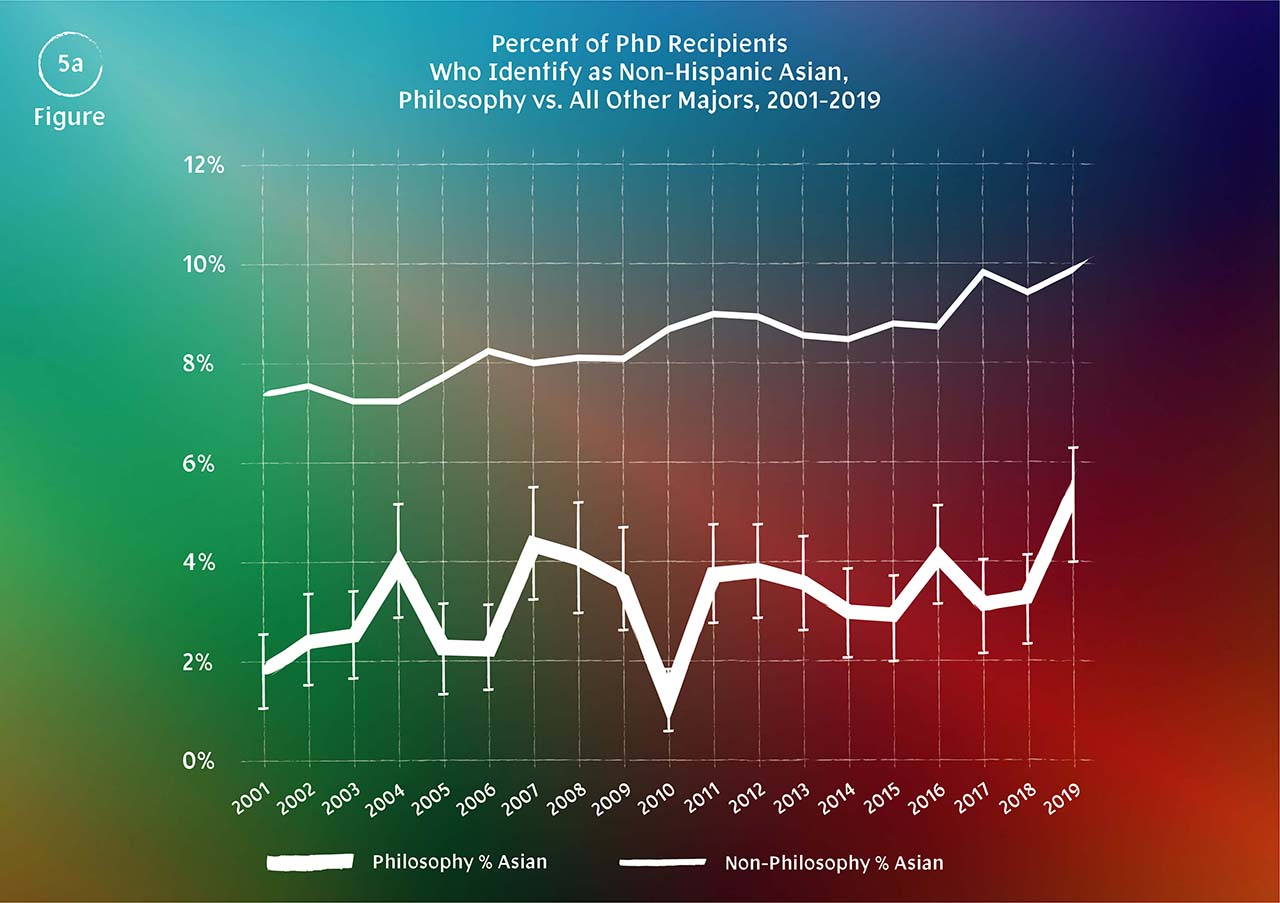
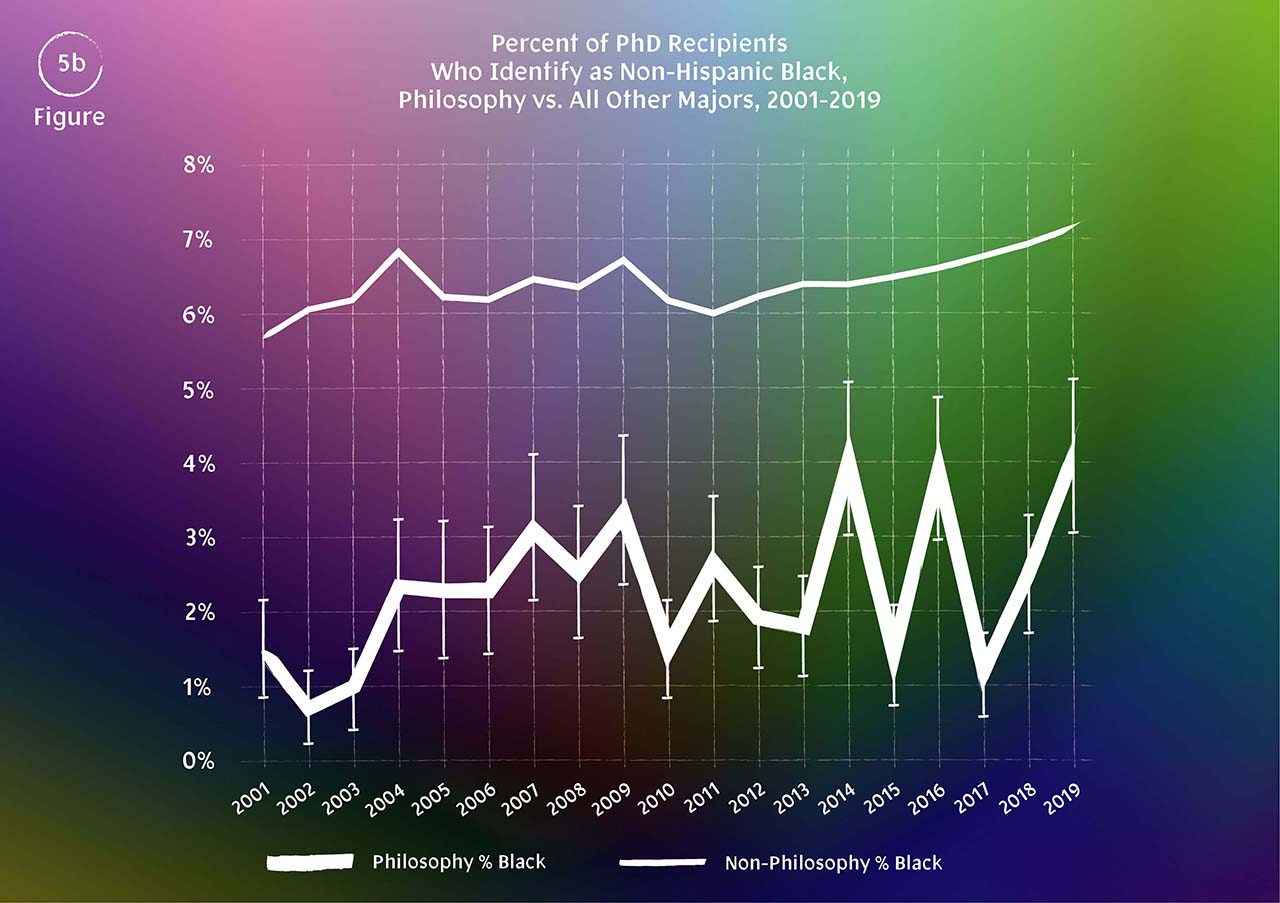
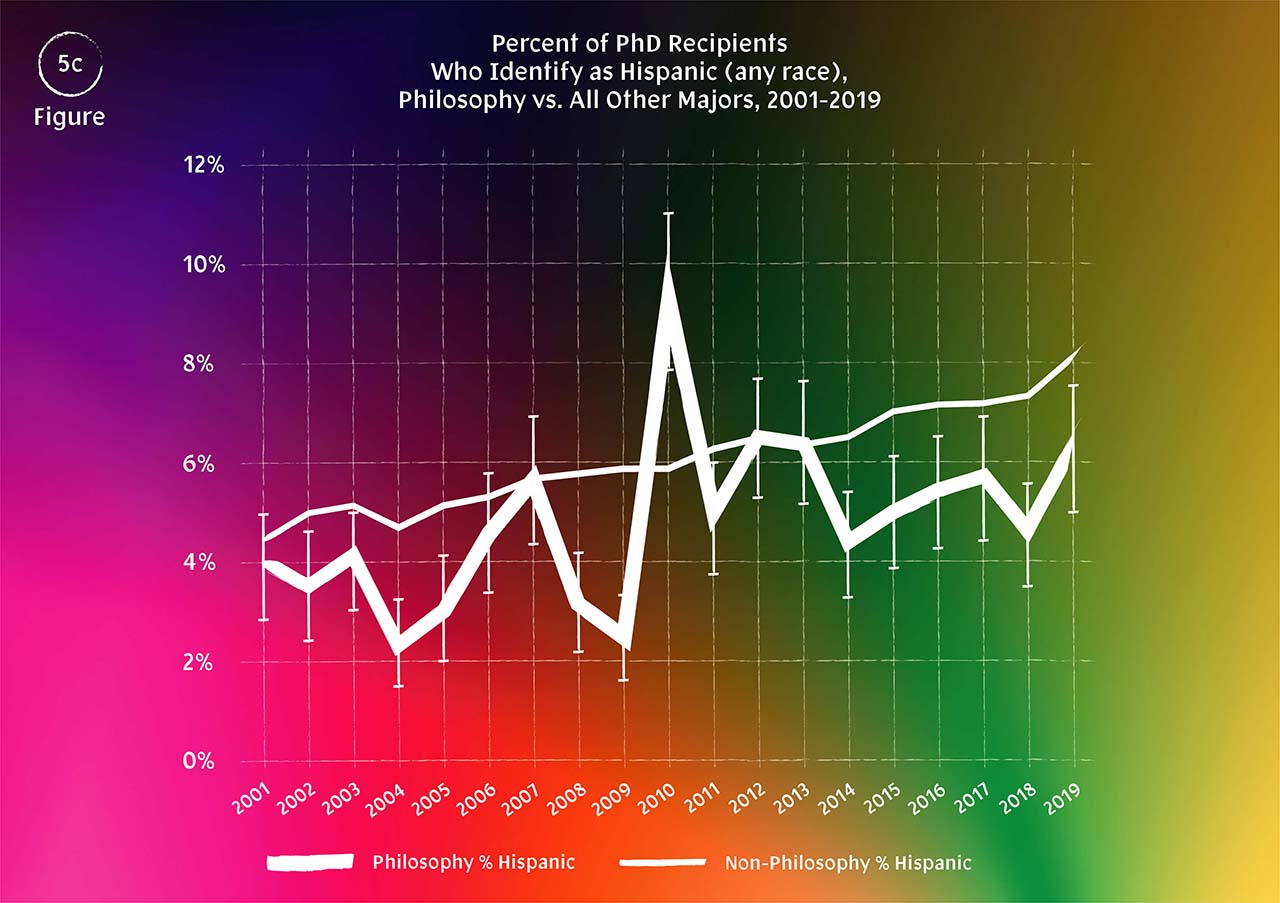
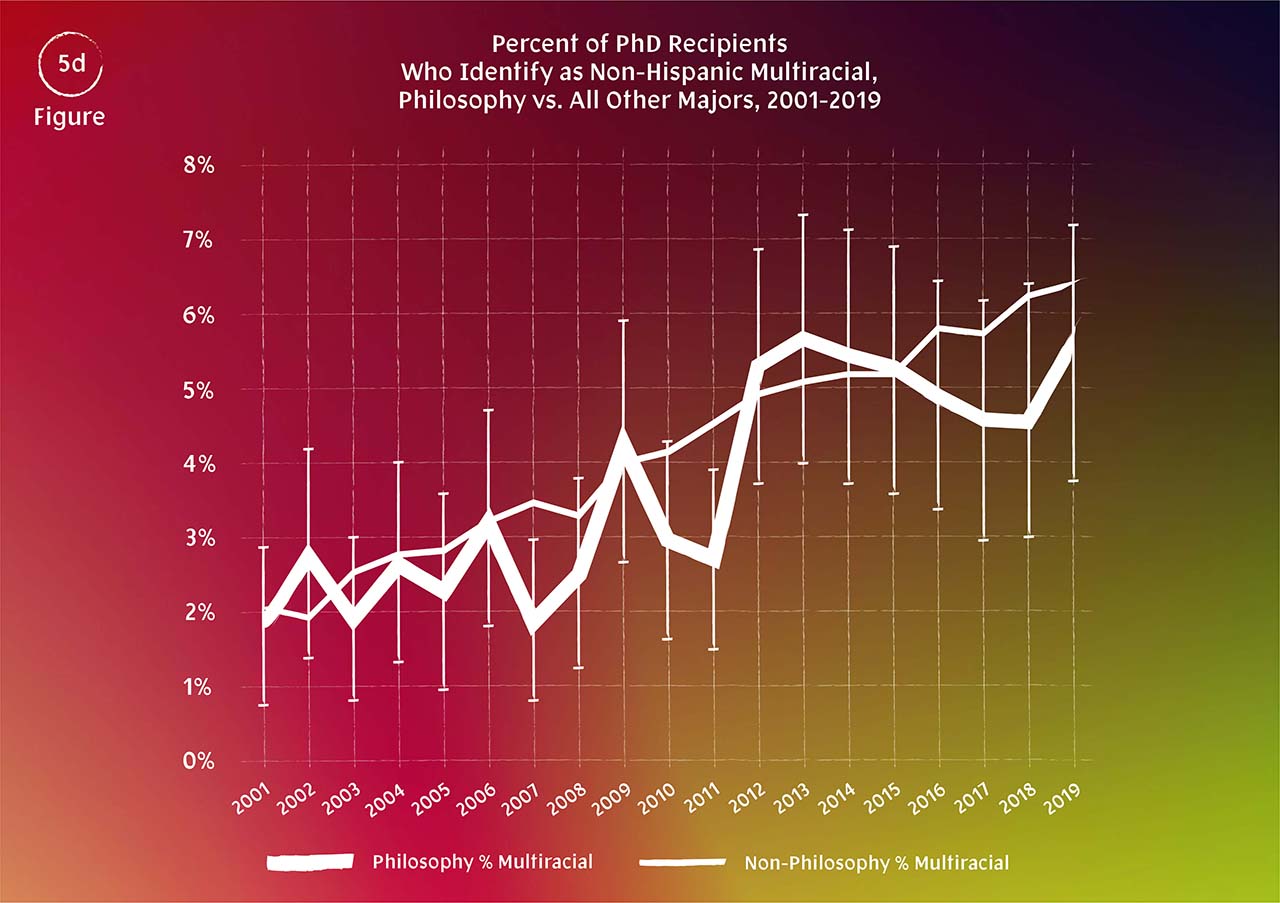
The SED uses the sex categories “male” and “female”, with no nonbinary categories. Very few students remain unclassified: 0.07% of PhD recipients overall and 0.06% of philosophy PhD recipients. Figure 6 shows temporal trends by gender. As is evident from the chart, and in keeping with the HERI and NCES data, philosophy PhD recipients remain disproportionately men compared to PhD recipients overall.
Figure 6. Completed research doctorates in philosophy by gender since 2001. Error bars indicate +/- one standard error.
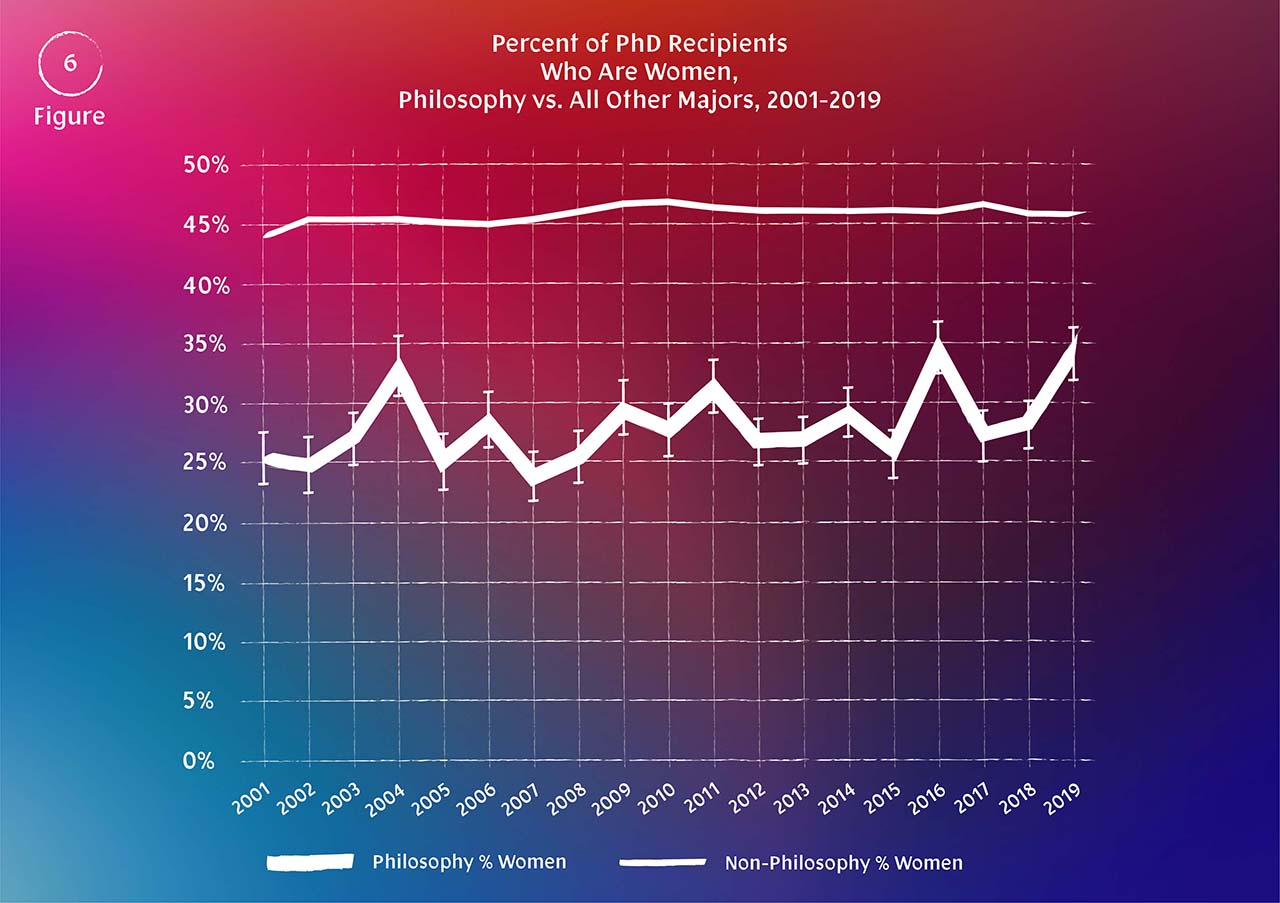
4. The Racial, Ethnic, and Gender Diversity of Philosophy Professors.
There are several good sources of recent gender data among philosophy professors in the U.S. Connecting PhD graduates to the professoriate, Academic Placement Data and Analysis (APDA) has collected data on recent PhD graduates from philosophy departments in the Anglophone world and their placement outcomes since 2011. Data are gathered and checked using both public (e.g. public placement pages on departmental websites) and non-public sources (e.g. self-report by PhD graduates). Gender is determined by self-report whenever possible, otherwise assigned by first name using an Application Programming Interface (genderize.io), or through publicly available information when the API categorisation is indeterminate. The APDA data are approximately complete for the years 2012-2018. Excluding 4% “unknown” or “prefer not to answer”, 29% of these graduates were women and 0.2% were nonbinary, with no striking temporal trends over this short period. In terms of placement, women make up 34% of those who graduated in this period who are now in tenure-track or equivalent positions, 25% of postdoctoral or fellowship positions, 23% of temporary academic positions, 28% of permanent lecturers and instructors, 30% of nonacademic positions, and 29% of those with unknown or no placement. APDA data from 2000 to 2020 for years outside the 2012-2018 range are incomplete, and so caution is warranted when looking at longer range temporal trends in this data. Nonetheless, the percentage of women graduates over this longer range does trend upward over this period, with a linear best fit line moving from around 25% to around 30%.
In 2020, the American Philosophical Association (APA) released a report, based primarily on 2017 data from the Philosophy Documentation Center (PDC), which attempts to list all full-time philosophy faculty in the United States (Nails and Davenport, 2020). The report employs the binary categories “male” and “female”, drawing on the PDC’s binary classifications and supplementing with online data when gender was not specified by the PDC. According to this report, as of 2017, 26% of philosophy faculty were women, including 34% of assistant professors, 28% of associate professors, 21% of full professors, and 26% of contingent faculty.
The Demographics in Philosophy project examined faculty lists on the department websites of 98 philosophy PhD granting institutions in the U.S., as of Fall 2019, coding each individual as woman, man, or nonbinary, based on pronoun usage, other publicly available data, and opportunities for correction by department heads and others. The data are not yet finalised, but publicly available draft data find 24% women faculty overall across all ranks and 4 nonbinary faculty (excluding 2 unclassified) (Peterson & Hustoft, 2021). Among non-emeritus tenure track faculty, 28% were women overall, including 43% of assistant professors, 32% of associate professors, and 22% of full professors.
Data on race and ethnicity are more difficult to obtain, and we know of no recent systematic reviews of the racial composition of philosophy faculty in the United States. However, the APA conducts an annual demographic survey, reporting summary data on race and other demographic characteristics of the members who respond to that survey. Among 2,430 APA full-member respondents who provided demographic information on race or ethnicity, 1% identified as Native American / Alaska Native, 6% identified as Asian, 4% identified as Black / African American, 5% identified as Hispanic / Latino, 0.1% identified as Pacific Islander, 82% identified as White / Caucasian, and 2% identified as “something else”. However, given that the Nails and Davenport report found 8,534 faculty in the PDC (6,647 in traditional ladder ranks), the APA member self-report data constitute only a possibly unrepresentative minority of faculty. In particular, the 4% Black / African American might be an overestimate, since it fits poorly with Botts and colleagues’ (2014) estimate of 1% and historical trends among PhD recipients in the NSF SED database, consistently 1-3% until a few 4% years recently.
In a 2018 self-report survey of recent PhDs (Jennings et al., 2019), APDA found that 6-9% of respondents identified as Chicanx/Latinx/Hispanic. In a separate question on race with 896 respondents, 87% identified as White, either alone or in combination with another race, 1% identified as American Indian or Alaskan Native, 7% identified as Asian or Pacific Islander, 1% as Black or African American, and 8% as Other, with 5% of respondents selecting more than one option. As with the APA data, caution is warranted due to the small, self-selected, and possibly unrepresentative sample.
5. Pipeline or Cohort?
Although the data from the different sources are not strictly comparable due to differences in collection method and in some cases the category labels, the HERI, NCES, and NSF data are nonetheless comparable for several target groups. This enables a comparison of percentages from first-year intention to major through receipt of the PhD. All of the target groups except for White and Men (which rise) and American Indian or Alaska Native (which remain approximately flat at less than 0.5%) constitute a smaller percentage of philosophy majors at the PhD level than in first-year intention to major, as displayed in Table 1. This could be due either to a “leaky pipeline”, in which Asian, Black, Hispanic, and women students are more likely to exit the major than White students and men, or to a cohort effect, reflecting the fact that the demographics of the completed PhD might be expected to match the demographics of entering students approximately 13 years earlier.
Table 1: Percentage of philosophy majors by race and gender at three different educational levels, aggregating over the most recent three years’ data. Race/ethnicity categories exclude Hispanic or Latino unless otherwise indicated.
|
Group |
First-year intention to major (2014-2016) |
Completed bachelor’s degree (2017-2019) |
Completed PhD (2017-2019) |
|
American Indian or Alaska Native |
0% |
0% |
0% |
|
Asian |
13% |
8% |
4% |
|
Black or African American |
9% |
6% |
3% |
|
Hispanic or Latino[6] |
11% |
14% |
6% |
|
White |
53% |
66% |
85% |
|
Multiracial[6] |
11% |
5% |
3% |
|
Women |
41% |
36% |
30% |
|
Men |
59% |
64% |
70% |
Figure 7: A visual representation of selected data from Table 1.
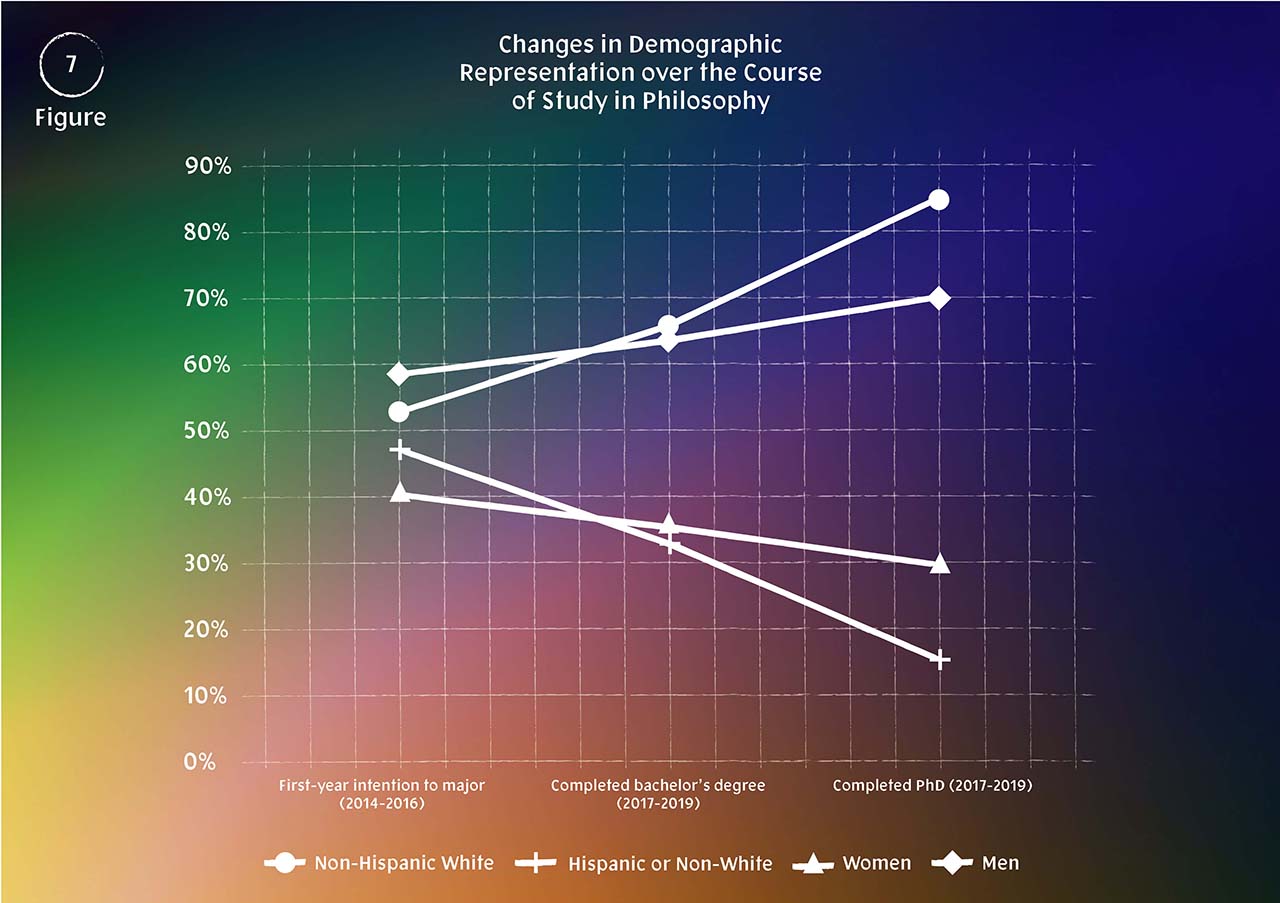
If we assume an eight year gap between receipt of Bachelor’s degree and receipt of PhD, then we can compare the demographics in three year period from 2009-2011 in the NCES data with the 2017-2019 period in the NSF data. Asian students received 7% of philosophy bachelor’s degrees in 2009-2011 compared with 4% of PhDs in 2017-2019. For Black students, the corresponding percentages are 5% and 3%, for Hispanic students 8% and 6%, for women students 31% and 30%. (Multiracial was a new category in NCES in 2008 and likely underreported for the first few years.) This approach is too imprecise for confident assessment across the different measurement techniques, but it suggests that the lower percentages of Asian, Black, and Hispanic students at the PhD level are partly pipeline effects not entirely due to cohort differences.
6. Conclusions.
We draw the following conclusions.
First, compared to their representation in the student body overall, Asian, Hispanic, and multiracial students are approximately proportionately represented in philosophy at the undergraduate level, from first-year intention to major through completion of the bachelor’s degree. Moreover, these proportions are increasing over time, tracking similar increases among undergraduates overall. However, Asian and Hispanic students appear to be underrepresented among PhD recipients in philosophy, compared to other disciplines, and Hispanic people are probably also underrepresented among faculty, compared to the U.S. population. Since 22% of the U.S. population aged 20-29 are Hispanic, their underrepresentation among recent philosophy PhDs (approximately 4%-9%) is especially striking.
Second, American Indians and Alaska Natives are underrepresented in philosophy. This is especially striking among PhD recipients, with only 11 non-Hispanic American Indian / Alaska Native PhD recipients recorded in the Survey of Earned Doctorates from 2001 through 2019 (0.17% of philosophy PhD recipients overall). Non-Hispanic American Indians and Alaska Natives constitute 0.9% of the U.S. population aged 20-29.
Third, people who identify as non-Hispanic Black are substantially underrepresented in philosophy at almost all levels, constituting about 6% of philosophy bachelor’s degree recipients, about 2.5% of philosophy PhD recipients, and based on the voluntary self-report of APA members possibly about 4% of philosophy faculty, despite constituting 12% of the U.S. population. Still, the percentage of philosophy bachelor’s recipients who are Black has been steadily climbing (from 4% in the early 2000s), and it appears recently to have risen sharply to 12% among first-year students intending to major in philosophy, though we have some concerns about the representativeness of those data and to what extent that increase will be reflected in bachelor’s degree recipients in a few years.
Fourth, women remain underrepresented in philosophy relative to both the student body as a whole and the U.S. population, constituting about 42% of first-year students intending to major in philosophy, about 40% of philosophy bachelor’s recipients, about 30% of philosophy Ph.D. recipients, about 34% of newly hired tenure-track faculty, and about 26% of full-time faculty overall. However, it is striking that in the most recent year’s data from the NCES, 38% of philosophy bachelor’s degree recipients were women, an encouraging rise after having fluctuated mostly in a band from 30%-34% from the 1980s to the mid-2010s (Schwitzgebel 2017b). A similar recent rise is evident in first-year intention to major, but not (yet) among PhD recipients.
Fifth, despite encouraging gains for some groups, especially at the undergraduate level, the “pipeline” into academic philosophy remains leaky, with substantially lower percentages at each educational level for all groups studied except White students and men.[7]
References
American Academy of Arts and Sciences (2019). Racial/ethnic distribution of degrees in philosophy. Humanities Indicators. https://www.amacad.org/humanities-indicators/higher-education/racialethnic-distribution-degrees-philosophy.
American Philosophical Association (1999). Report from the Committee on Hispanics/Latinos. Proceedings and Addresses of the American Philosophical Association, 73 (2), 95-99.
Antony, L. (2012). Different voices or perfect storm: Why are there so few women in philosophy? Journal of Social Philosophy, 43 (3), 227–255.
Behrensen, M., & Kaliarnta, S. (2017). Sick and tired: Depression in the margins of academic philosophy. Topoi, 36, 355–364.
Botts, T., Bright, L., Cherry, M., Mallarangeng, G., & Spencer, Q. (2014). What is the state of Blacks in philosophy? Critical Philosophy of Race, 2, 224-242.
Bright, L. K. (2016). Publications by Black authors in Leiter top 15 journals, 2003-2012. Blog post at The Splintered Mind (Jan. 18). https://schwitzsplinters.blogspot.com/2016/01/publications-by-black-authors-in-leiter.html.
Calhoun, C. (2009). The undergraduate pipeline problem. Hypatia 24, 216–223.
Chattopadhyay, S., Myser, C., & de Vries, R. (2013). Bioethics and its gatekeepers: Does institutional racism exist in leading bioethics journals? Journal of Bioethical Inquiry, 10, 7-9.
Contesi, F., & Terrone, E., (2018). Linguistic injustice and analytic philosophy: Introduction, Philosophical Papers, 47 (1), 1-20.
De Cruz, H. (2018). Prestige bias: An obstacle to a just academic philosophy. Ergo, 5 (10). https://doi.org/10.3998/ergo.12405314.0005.010
Gines, Kathryn T. (2011). Being a Black woman philosopher: Reflections on founding the Collegium of Black Women Philosophers. Hypatia, 26, 429-43.
Guerrero, Alex (2015). Journals and diversity. Blog post at Discrimination and Disadvantage (May 29). https://philosophycommons.typepad.com/disability_and_disadvanta/2015/05
Hutchison, K., & Jenkins, F., eds. (2013). Women in philosophy: What needs to change? Oxford University Press.
Jennings, C. D. (2019). Graduate students on diversity and inclusivity in philosophy. Blog post at Daily Nous (Sep. 3). https://dailynous.com/2019/09/03/graduate-students-diversity-inclusivity-philosophy-guest-post-carolyn-dicey-jennings.
Jennings, C. D., Fronda, R., Hunter, M. A., Johnson King, Z.A., Spivey, A. C., & Wilson, S. (2019). The Diversity and Inclusivity Survey: Final Report. https://cdn.ymaws.com/www.apaonline.org/resource/resmgr/data_on_profession/apda_final_report_2019.pdf
Lee, Carole J. (2014). Asian Americans, positive stereotyping, and philosophy. APA Newsletter on Asian and Asian American Philosophers and Philosophies, 14 (1), 2-7.
Lockard, C. A., Meskhidze, H., Wilson, S., Batchelor, N., Bloch-Schulman, S., & Cahill, A. J. (2017). Using focus groups to explore the underrepresentation of female-identified undergraduate students in philosophy. Feminist Philosophy Quarterly, 3 (4), article 4. https://doi.org/10.5206/fpq/2017.4.4.
Mills, C. W. (2015). Blackness visible. Cornell University Press.
Outlaw, L. T. (1996). On race and philosophy. Psychology Press.
Paxton, M., Figdor, C., & Tiberius, V. (2012). Quantifying the gender gap: An empirical study of the underrepresentation of women in philosophy. Hypatia, 27 (4), 949-957.
Peterson, G., & Hustoft, Z. (2021). Second wave survey of women’s representation in U.S. philosophy graduate programs. Harvard Dataverse, V1. https://doi.org/10.7910/DVN/IJZW8Y
Schwitzgebel, E. (2017a). The racial diversity of philosophy majors. Blog post at Daily Nous (Dec. 21). https://dailynous.com/2017/12/21/racial-diversity-philosophy-majors-guest-post-eric-schwitzgebel.
Schwitzgebel, E, (2017b). Women have been earning 30-34% of philosophy BAs in the U.S. since approximately forever*. Blog post at The Splintered Mind (Dec. 8). http://schwitzsplinters.blogspot.com/2017/12/women-have-been-earning-30-34-of.html
Schwitzgebel, E., Huang, L. T., Higgins, A., & Gonzalez-Cabrera, I. (2018). The insularity of Anglophone philosophy: Quantitative analyses. Philosophical Papers, 47 (1), 21-48.
Schwitzgebel, E., & Jennings, C. D. (2017). Women in philosophy: Quantitative analyses of specialization, prevalence, visibility, and generational change. Public Affairs Quarterly, 31 (2), 83-105.
Thompson, M., Adleberg, T., Sims, S., & Nahmias, E. (2016). Why do women leave philosophy? Surveying students at the introductory level. Philosophers’ Imprint, 16 (6), 1-36. http://hdl.handle.net/2027/spo.3521354.0016.006.
Tremain, S. (2013). Introducing feminist philosophy of disability. Disability Studies Quarterly, 33 (4). https://dsq-sds.org/article/view/3877.
Tremain, S. (2018). Philosophy and the apparatus of disability. In A. Cureton & D. Wasserman eds., Oxford Handbook of Philosophy and Disability. Oxford University Press.
Van Norden, B. W. (2017). Taking back philosophy. Columbia University Press.
Whyte, Kyle (2017). Indigenous research and professional philosophy in the U.S. Blog post at Philosopher (Feb. 3). https://politicalphilosopher.net/2017/02/03/featured-philosopher-kyle-whyte/
[1] Race: Outlaw, 1996; Gines, 2011; Botts, Bright, Cherry, Mallarangeng, & Spencer 2014; Lee, 2014; Mills, 2015; Bright, 2016; Schwitzgebel, 2017a; Whyte, 2017; American Academy of Arts and Sciences, 2019. Gender: Calhoun, 2009; Antony, 2012; Paxton, Figdor, & Tiberius, 2012; Hutchison & Jenkins, 2013; Thompson, Adleberg, Sims, & Nahmias, 2016; Lockard, Meskhidze, Wilson, Batchelor, Bloch-Schulman, & Cahill, 2017; Schwitzgebel & Jennings, 2017; Hassoun, 2016; Wilhelm, Conklin, & Hassoun, 2018. Ethnicity or national background: American Philosophical Association, 1999; Chattopadhyay, Myser, & de Vries, 2013; Guerrero, 2015; Van Norden, 2017; Contesi & Terrone, 2018; Schwitzgebel, Huang, Higgins, & Gonzalez-Cabrera, 2018. Socio-economic status: De Cruz, 2018; Jennings, 2019. Disability status: Tremain, 2013; Behrensen & Kaliarnta, 2017; Tremain, 2018.
[2] HERI attempts to compensate for these shortcomings by means of a proprietary constructed variable that weights responses unevenly. We found that using this variable greatly increases noise and reduces statistical power by considerably overweighting some students’ responses while not substantially changing the general trends we report here. Therefore, we rely on raw response data for the analyses in the main text.
[3] All census data reported in this article are from the 2010 census, representing approximately the middle of the target period, calculated from tables available at: https://www.census.gov/data/tables/time-series/demo/popest/2010s-national-detail.html [accessed Feb. 24, 2021]. Unless otherwise specified, racial data include respondents indicating that race alone (rather than multiracial), not Hispanic, to best match the reporting categories of the databases we employ in this article.
[4] Sex (e.g. “female”) and gender terms (e.g. “woman”) are often used interchangeably in everyday speech, but for studies targeting gender diversity precision on these terms is important. While some sources of data (HERI, NSF, and APDA) have collected data using the response items “Female” and “Male,” we interpret these questions as measuring self-reported gender identification. For all data presented, there were no additional questions using alternative categories such as “Woman” and “Man.” Thus, we assume that responses are actually in terms of gender categories (social categories based on self-identification or gender expression) rather than sex categories (referring to primary and secondary sex characteristics).
[5] “Native Hawaiian and Other Pacific Islander” is included as a questionnaire response category. However, in the NSF’s public data presentation it was aggregated with “Asian” from 2001-2016 and then with “other” starting in 2017.
[6] For first-year intention to major, students identifying as Hispanic plus any other race/ethnicity are classified as multiracial. For bachelor’s and PhD, those students are classified as Hispanic rather than as multiracial.
[7] This research was partially funded by a grant from the American Philosophical Association.
*************
Eric Schwitzgebel is professor of philosophy at University of California, Riverside, and author most recently of A Theory of Jerks and Other Philosophical Misadventures.
Liam Kofi Bright is assistant professor of philosophy, logic and scientific method at the LSE. His interests include social epistemology and the philosophy of science.
Carolyn Dicey Jennings is associate professor of philosophy and cognitive science at University of California Merced, author of The Attending Mind (CUP 2020), and principal investigator of Academic Placement Data and Analysis (placementdata.com).
Morgan Thompson is a postdoctoral researcher at Bielefeld Universität. Her interests include the philosophy of science and feminist philosophy.
Eric Winsberg is professor of philosophy at the University of South Florida. He is author of Philosophy and Climate Science and Science in the Age of Computer Simulation.
This research was partially funded by a grant from the American Philosophical Association.

